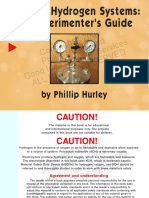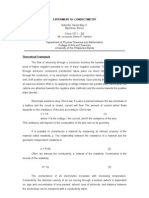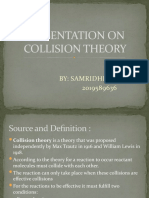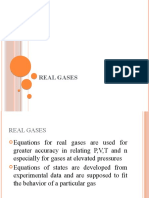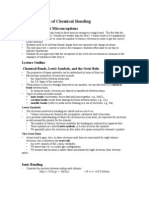Galvanic Cell
Galvanic Cell
Uploaded by
Asep Ridwan SetiawanCopyright:
Available Formats
Galvanic Cell
Galvanic Cell
Uploaded by
Asep Ridwan SetiawanOriginal Description:
Original Title
Copyright
Available Formats
Share this document
Did you find this document useful?
Is this content inappropriate?
Copyright:
Available Formats
Galvanic Cell
Galvanic Cell
Uploaded by
Asep Ridwan SetiawanCopyright:
Available Formats
9-1
Experiment 9 Electrochemistry I Galvanic Cell
Introduction: Chemical reactions involving the transfer of electrons from one reactant to another are called oxidation-reduction reactions or redox reactions. In a redox reaction, two half-reactions occur; one reactant gives up electrons (undergoes oxidation) and another reactant gains electrons (undergoes reduction). A piece of zinc going into a solution as zinc ions, with each Zn atom giving up 2 electrons, is an example of an oxidation half-reaction. Zn(s) Zn2+(aq) + 2e(1)
The oxidation number of Zn(s) is 0 and the oxidation number of the Zn2+ is +2. Therefore, in this half-reaction, the oxidation number increases, which is another way of defining an oxidation. In contrast, the reverse reaction, in which Zn2+ ions gain 2 electrons to become Zn atoms, is an example of reduction. Zn2+(aq) + 2e- Zn(s) (2)
In a reduction there is a decrease (or reduction) in oxidation number. Chemical equation representing half-reactions must be both mass and charge balanced. In the half-reactions above, there is one zinc on both sides of the equation. The charge is balanced because the 2+ charge on the zinc ion is balanced by two electrons, 2e-, giving zero net charge on both sides. Another example of reduction is the formation of solid copper from copper ions in solution. Cu2+(aq) + 2e- Cu(s) (3)
In this half-reaction the oxidation number of the aqueous copper is +2, which decreases to 0 for the solid copper, and again charge and mass are balanced. However, no half-reaction can occur by itself. A redox reaction results when an oxidation and a reduction half-reaction are combined to complete a transfer of electrons as in the following example: Zn(s) + Cu2+(aq) Zn2+(aq) + Cu(s) (4)
The electrons are not shown because they are neither reactants nor products but have simply been transferred from one species to another (from Zn to Cu2+ in this case). In this redox reaction, the Zn(s) is referred to as the reducing agent because it causes the Cu2+ to be reduced to Cu. The Cu2+ is called the oxidizing agent because it causes the Zn(s) to be oxidized to Zn2+. Any half-reaction can be expressed as a reduction as illustrated in the case where equation (1) can be reversed to equation (2). A measure of the tendency for a reduction to occur is its reduction potential, E, measured in units of volts. At standard conditions, 25 C and concentrations of 1.0 M for the aqueous ions, the measured voltage of the reduction halfreaction is defined as the standard reduction potential, E. Standard reduction potentials
UCCS Chem 106 Laboratory Manual
Experiment 9
9-2
have been measured for many half-reactions and they are listed in tables. A short list is also provided at the end of the In-Lab section. For the reduction half-reactions in equations (2) and (3), the standard reduction potentials are 0.76 V for zinc and +0.34 V for copper. The more positive (or less negative) the reduction potential, the greater is the tendency for the reduction to occur. So Cu2+ has a greater tendency to be reduced than Zn2+. Furthermore, Zn has a greater tendency to be oxidized than Cu. The values of E for the oxidation halfreactions are opposite in sign to the reduction potentials: +0.76 V for Zn and 0.34 V for Cu. A galvanic cell or voltaic cell is a device in which a redox reaction, such as the one in equation (4), spontaneously occurs and produces an electric current. In order for the transfer of electrons in a redox reaction to produce an electric current and be useful, the electrons are made to pass through an external electrically conducting wire instead of being directly transferred between the oxidizing and reducing agents. The design of a galvanic cell (shown in Figure 1 for the equation (4) reaction) allows this to occur. In a galvanic cell, two solutions, one containing the ions of the oxidation half-reaction and the other containing the ions of the reduction half-reaction, are placed in separated compartments called half-cells. For each half-cell, the metal, which is called an electrode, is placed in the solution and connected to an external wire. The electrode at which oxidation occurs is called the anode [Zn in equation (4)] and the electrode at which reduction occurs is called the cathode [Cu in equation (4)]. The two half-cells are connected by a salt-bridge that allows a current of ions from one half-cell to the other to complete the circuit of electron current in the external wires. When the two electrodes are connected to an electric load (such as a light bulb or voltmeter) the circuit is completed, the oxidation-reduction reaction occurs, and electrons move from the anode () to the cathode (+), producing an electric current.
Figure 1. Galvanic cell (or battery) based on the redox reaction in equation (4). The cell potential, Ecell, which is a measure of the voltage that the battery can provide, is calculated from the half-cell reduction potentials: Ecell = Ecathode - Eanode
UCCS Chem 106 Laboratory Manual
Experiment 9
9-3
At standard conditions, indicated by the superscript o, the standard cell potential, Ecell, is based upon the standard reduction potentials, as shown in equation (5). Ecell = Ecathode Eanode (5)
Based on the values for the standard reduction potentials for the two half-cells in equation (4) [0.76 V for zinc anode and +0.34 V for copper cathode], the standard cell potential, Ecell, for the galvanic cell in Figure 1 would be: Ecell = +0.34 V (0.76 V) = +1.10 V The positive voltage for Eocell indicates that at standard conditions the reaction is spontaneous. Recall that Go = nFEocell, so that a positive Eocell results in a negative Go. Thus the redox reaction in equation (4) would produce an electric current when set up as a galvanic cell. When conditions are not standard, the Nernst equation, equation (6), is used to calculate the potential of a cell. In the Nernst equation, R is the universal gas constant with a value of 8.314 J/(Kmol), T is the temperature in K, and n is the number of electrons transferred in the redox reaction, for example, 2 electrons in equation (4). Q is the reaction quotient for the ion products/ion reactants of the cell. The solid electrodes have constant concentrations and so do not appear in Q. F is the Faraday constant with a known value of 96,500 J/(Vmol).
RT 0 Ecell = Ecell (ln Q ) nF
(6)
For our equation (4) example, Zn(s) + Cu2+(aq) Zn2+(aq) + Cu(s), so Q and ln Q are:
Q= [Zn 2+ ] [Cu 2+ ]
and
ln Q = ln [Zn2+] ln [Cu2+]
Since in equation (4), n = 2, the Nernst equation for this redox reaction becomes:
RT RT 0 2+ 2+ E cell = Ecell ln[ Zn ] + ln[Cu ] 2 F 2 F
(7)
In a series of galvanic cells, in which [Zn2+] is kept constant while [Cu2+] is varied, Ecell can be measured and it will be found to vary with ln[Cu2+]. A plot of the data obtained in which y is Ecell and x is ln[Cu2+] will result in a straight line: y = mx + b. For equation (7), the terms Ecell and [RT/2F]ln [Zn2+] are constant and together they equal the intercept, b, of the line. [RT/2F] will be the constant slope, m, provided the temperature is constant.
UCCS Chem 106 Laboratory Manual
Experiment 9
9-4
Thus a plot such as the one shown below can be generated by measuring the cell potential for different values of [Cu2+], while keeping [Zn2+] constant (at 1.0 M in this plot). The equation of the line in this plot can then be used to determine ln [Cu2+] in a solution of unknown concentration from its measured Ecell, as long as [Zn2+] remains at 1.0 M and the temperature at 25oC. This is the same principle used in a pH meter for the determination of [H+]. Notice that as the concentration of Cu2+ ion reactant increases (or ln[Cu2+] becomes less negative), the potential of the cell increases.
Nernst plot: Zn(s )|Zn ||Cu |Cu(s )
([Zn 2+] a t 1.0 M ) 1.120 1.080 1.040 Ecell (V) 1.000 0.960 0.920 0.880 -14.00
2+ 2+
-12.00
-10.00
-8.00
-6.00
2+
-4.00
-2.00
0.00
ln[Cu ]
Figure 2. Nernst plot of Ecell vs. ln [Cu2+] with [Zn2+] constant at 1.0 M. Note the standard cell notation in the graph title for the galvanic cell. Part A. Redox Reactions: In this experiment you will observe several redox reactions in which metals are placed in solutions containing different metal ions. From your observations you will determine whether a redox reaction is occurring and write balanced redox equations for any that occur. For example, since as shown above, Cu2+ has a greater tendency to be reduced than Zn2+, you would expect that placing Zn metal into a solution of Cu2+ ions would result in a direct redox reaction. Cu2+ ions are reduced to Cu metal which is deposited on the Zn metal surface, while the Zn metal is oxidized to Zn 2+ ions which go into the solution. The redox equation for this reaction is therefore equation (4). Part B: Reduction Potentials: You will then construct a series of three galvanic cells combining the zinc half-reaction with three different metal half-reactions (Cu, Fe and Pb). You will measure the cell potentials, Ecell, using a Vernier voltage probe as shown in Figure 3. You will use 1.0 M solutions for both half-cells, so Q = 1 and lnQ = 0 for the reaction. Thus the cell potential measured will be the same as Ecell as evident from the Nernst equation (6). You will then use your
UCCS Chem 106 Laboratory Manual
Experiment 9
9-5
measured Ecell values, the known zinc standard reduction potential, E = 0.76 V, and equation (5) to calculate the E values for the three different half-reactions. Part C: Nernst Equation for varying Cu2+ concentrations: Galvanic cells with different known Cu2+ concentrations and a fixed Zn2+ concentration will be prepared and their cell potentials measured. A plot of the Nernst equation, Ecell vs. ln[Cu2+], constructed from this data will then be used to find [Cu2+] of an unknown solution. Part D: Determine the E for a voltaic cell using Cu and unknown metal: Finally, you will measure the potential of a voltaic cell combining an unknown metal electrode with Cu (E = 0.34 V). By measurement of the cell potential and use of equation (5), you will identify the unknown metal from its calculated value of E. The unknown will have a more negative E than Cu, so the Cu will have a greater tendency to be reduced and thus will be the cathode when the Ecell is positive. Pre-Lab Notebook: Provide a title, purpose, and a brief summary of the procedure in your lab notebook before coming to lab. Equipment: 12-Well Microcell plate 24-Well Microcell plate 1.00 mL Pipet Pipet bulb 50 mL Beakers (5) Forceps In Lab Procedure: Note: Work in pairs Part A. Redox Reactions: 1. Fill four cells in each of four columns of a 24-well microcell plate about three-fourths full with 1.0 M Cu(NO3)2, 1.0 M FeSO4, 1.0 M Pb(NO3)2, and 1.0 M Zn(NO3)2 as shown in the diagram below. 2. Polish small strips (4 each) of Cu, Fe, Pb and Zn with steel wool or sand paper and place them on a paper towel with written labels to insure that the metals are not mixed up with each other. Partially submerge the strips into the cell rows as shown below. Place only part of the metal into the solution so that any sign of a reaction (such as deposit of a metal on the submerged part of the strip) can be determined by comparison with the unsubmerged portion of the metal strip. Cu(NO3)2 Cu(s) Fe(s) Pb(s) Zn(s) FeSO4 Pb(NO3)2 Zn(NO3)2 Vernier LabPro TI-84 Calculator Vernier Voltage Probe Steel Wool Filter paper strips 100.00 mL Volumetric flasks (3)
UCCS Chem 106 Laboratory Manual
Experiment 9
9-6
3. After 5 minutes examine each cell carefully to see if any metal displacement redox reaction has occurred. Record your observations in a table as shown above in your laboratory notebook. Then repolish and rinse the strips and return them to labeled paper towels located at the rear of the lab. If you are unsure about the identity of any strips, give them to your lab instructor. Part B: Reduction Potentials: 1. Before constructing the galvanic cells, set up the Vernier system in DATAMATE with the voltage probe connected to channel 1 of the LabPro interface. 2. Hit CLEAR on the main screen of DATAMATE and the program will check for sensors. Once the voltage probe has been identified, and a reading near 0 volts is shown, you are ready to record data from the main screen. Obtain a 1.5 V battery from the instructors desk and connect the red lead of the voltage probe to the (+) end of the battery (the cathode) and the black lead to the () end (the anode). If the voltage reading is not 1.5 V +/ 0.2 V, inform you instructor. 3. Wet a 23 inch long strip of filter paper with KNO3 solution. Remove excess liquid gently (the paper easily rips when wet!) by blotting it on a paper towel and fold the paper into a U-shape; this will serve as your salt bridge. Place the salt bridge so that it will be immersed into each of two solutions in adjacent wells of a 12-well microcell plate (see Figure 3 below). 4. Construct a galvanic cell by adding solutions of 1.0 M Cu(NO3)2 as the aqueous Cu2+ and 1.0 M Zn(NO3)2 as the aqueous Zn2+ to the two adjacent wells. Do not immerse the copper and zinc at this time. Connect the leads from the voltage probe to the zinc and copper electrodes. Recall that the red lead must be connected to the cathode and the black to the anode to obtain a positive cell voltage. 5. Immerse the electrodes in the solutions and remove them in 5-10 seconds while avoiding contact with the salt bridge. If the voltage reading on the Vernier calculator is positive, the electrodes are connected correctly; if not, repolish and rinse the electrodes and reverse the connections.
To Vernier Filter paper salt bridge Microcell plate
Figure 3. Galvanic cell apparatus for Part B.
UCCS Chem 106 Laboratory Manual
Experiment 9
9-7
6. Record the positive cell potential, in volts, in your laboratory notebook. You will find that the voltage recorded is less than what you would expect based on standard reduction potentials. For example the Zn/Cu cell may be less than the 1.10 V calculated in the Introduction section. This is partly due to the presence of an oxide formed on one of the electrodes, a process which occurs very rapidly for easily oxidized metals and which changes the half-cell potential. 7. Repeat steps 3-6 for galvanic cells of Fe(in 1.0 M FeSO4) - Zn and Pb(in 1.0 M Pb(NO3)2) - Zn. Use a freshly prepared filter paper strip for the salt bridge of each cell. Part C: Nernst Equation for varying Cu2+ concentrations: 1. Prepare three dilute solutions of CuSO4 by serial dilution from a 1.0 M CuSO4 stock solution as follows: Transfer1.0 mL of 1.0 M CuSO4 stock solution into a labeled (with tape) 100.00 mL volumetric flask and dilute to the mark with de-ionized water to form a 0.01 M solution. Rinse the pipet with a small volume of the solution to be transferred prior to use. Next take the 0.01 M solution just formed and transfer 1.0 mL of it into a labeled 100.00 mL volumetric flask. Dilute to the mark with de-ionized water to form the 0.0001 M solution. Repeat one more time so that you have the following set of solutions in labeled flasks: Solution A 1 M CuSO4 (stock solution) Solution B 0.01 M CuSO4 Solution C 0.0001 M CuSO4 Solution D 0.000001 M CuSO4 2. Prepare a half-cell of Cu2+ by placing the copper solution D into a 12-microcell well. 3. Remove the copper and zinc electrodes from the half-cells used previously and clean and re-polish them. 4. Place 1.0 M Zn(NO3)2 in a cell next to the Cu2+ half-cell. Connect the two half-cells with a freshly prepared salt bridge. Connect the copper and zinc electrodes to the correct voltage probe leads. Measure and record the cell potential in your laboratory notebook using the same technique (5-10 second immersion) with the voltage probe as in Part B. 5. Remove the CuSO4 solution with a disposable pipet and repeat the measurement of Ecell (steps 3-4) for the remaining three copper solutions in order of increasing concentration. Then, in the same way, measure the Ecell for the unknown Cu2+ solution. Record the measured values in a table as shown below in your notebook. Solution [Cu2+] Volts D 0.000001 M C 0.0001 M B 0.01 M A 1.0 M Unknown ?
Part D: Determine the E for a voltaic cell using Cu and unknown metal:1 1. Obtain a small amount of the unknown electrolyte solution labeled 1.0 M X ion and the corresponding metal strip, X. This metal is one of the metals in the table of Standard Reduction Potentials at the end of the In-Lab section. 2. Use a disposable pipet to transfer a small amount of 1.0 M X ion solution to a well adjacent to the 1.0 M CuSO4 solution in a 12-microcell-test plate. 3. Make a new salt bridge by soaking a short length of filter paper in the KNO3 solution. 4. Connect the X and Cu half-cells with the filter paper. Measure the positive potential of the X-Cu voltaic cell using the same technique as in Part B (Red lead to the Cu, which is the cathode).
UCCS Chem 106 Laboratory Manual
Experiment 9
9-8
5. After recording the potential once (5-10 seconds), remove both electrodes from the solutions and clean and polish each electrode. Set up the galvanic cell again. Connect the voltage probe as before. 6. Record the potential again. If the two measured potentials do not agree within .1 volts, test the galvanic cell a third time and record the potential immediately after making the connection with the voltage probe. Calculate the average of the measured potentials to use in the Post-Lab calculation.
Standard Reduction Potentials: Electrode Ag+ + e Ag Cu2+ + 2e Cu Pb2+ + 2e Pb Fe2+ + 2e Fe Zn2+ + 2e Zn Al3+ + 3e Al Mg2+ + 2e Mg Literature Cited:
1. Advanced Chemistry with Vernier: Experiments for AP, IB, and College General Chemistry, Jack Randall, Vernier Software and Technology, 2004, 20-1.
Eo +0.80 V +0.34 V 0.13V 0.44 V 0.76 V 1.66 V 2.37 V
UCCS Chem 106 Laboratory Manual
Experiment 9
9-9
Lab Report Outline for Electrochemistry I Graded Sections of Report Pre-Lab In-Lab Post-Lab Part A. Redox Reactions: For each of the metals, indicate the redox reactions you observed in a table as shown below. Write NR for (no reaction) where none was observed. 10 Cu(NO3)2 FeSO4 Pb(NO3)2 Zn(NO3)2 Cu(s): Fe(s): Pb(s): Zn(s): ** Explain your observations by calculating the Eo for each reaction observed using equation (5) and values for the standard reduction potentials of the metals to determine why certain reactions are spontaneous (** e.g., Cu2+ + Zn Cu + Zn2+, E0cell = 1.10V) 10 Part B: Reduction Potentials: Report the cell potential for each galvanic cell and state which electrode corresponds to the cathode and which to the anode. Given Eo = 0.76 V for the Zn2+ / Zn half-cell, and your measured Eocell, calculate the reduction potential at the Cu, Fe, and Pb cathodes 15 Galvanic cell Ecell , Cathode half- Anode halfReduction Volts reaction reaction Potential, volts Cu(s) - Zn(s): Fe(s) - Zn(s): Pb(s) - Zn(s): 1. Show a sample calculation for the case of the Fe(s) - Zn(s) cell. 5 Part C: Nernst Equation: 1. Construct and attach to your report a graph (similar to that shown in Figure 2) of the 5 measured values of Ecell versus ln[Cu2+] from your data table. 2. Find the best fit line for the plot and state: The equation of the line is ______. 5 3. From the equation for the line, determine [Cu2+] of the unknown solution. State: The [Cu2+] of the unknown solution is _______. 10 Part D: Determine the E for a voltaic cell using Cu and an unknown metal:1 1.Use equation (5) to solve for E anode of the unknown metal, keeping in mind that the Cu is the cathode for the cell when the Ecell is positive. Show the calculation of E anode . 10 2. Compare the E anode of the unknown to the values listed in the table given at the end of the In-Lab section and state: The unknown metal is ________. 10 Percent of Grade 10 10
UCCS Chem 106 Laboratory Manual
Experiment 9
9-10
UCCS Chem 106 Laboratory Manual
Experiment 9
You might also like
- Experiment 4: Effect of Concentration and Temperature On Rate of Reaction (Dissappearing Cross)Document24 pagesExperiment 4: Effect of Concentration and Temperature On Rate of Reaction (Dissappearing Cross)Malini RajeshNo ratings yet
- Concepts For Large Scale Hydrogen Liquefaction Plants PDFDocument179 pagesConcepts For Large Scale Hydrogen Liquefaction Plants PDFDilla Wahab100% (1)
- CHM12 Experiment 5 KineticsDocument15 pagesCHM12 Experiment 5 Kineticsshaam030% (2)
- Week 2 Chemical Kinetics Analysis of Rate EquationDocument31 pagesWeek 2 Chemical Kinetics Analysis of Rate EquationPeachYpeachasNo ratings yet
- Combination CircuitsDocument15 pagesCombination CircuitstjmNo ratings yet
- How To Set Up An Electrolytic CellDocument6 pagesHow To Set Up An Electrolytic CellAngel LacabaNo ratings yet
- Electrochemical Cell LabDocument9 pagesElectrochemical Cell Labribots0% (1)
- Philip Hurley Fuel CellDocument378 pagesPhilip Hurley Fuel CellAsep Ridwan SetiawanNo ratings yet
- Rate of Reaction Between Sodium Thiosulphate COURSWORK CHEMISTRY .IDocument29 pagesRate of Reaction Between Sodium Thiosulphate COURSWORK CHEMISTRY .IAnonymous pgjIAZo100% (8)
- Investigation of Enthalpy of Reaction Pre Lab Sem2 2021Document1 pageInvestigation of Enthalpy of Reaction Pre Lab Sem2 2021ELLENA SANTOSNo ratings yet
- Experiment Seven - Electrochemical CellsDocument7 pagesExperiment Seven - Electrochemical CellsLance A. Schell100% (4)
- PotentiometryDocument4 pagesPotentiometryalexpharmNo ratings yet
- Electrochemical Cell in ChemistryDocument20 pagesElectrochemical Cell in ChemistryKh See100% (1)
- Department of Chemical EngineeringDocument12 pagesDepartment of Chemical EngineeringSheikh AliNo ratings yet
- Equilibrium Electrode Potential: Nernst EquationDocument10 pagesEquilibrium Electrode Potential: Nernst EquationSmruthi SuvarnaNo ratings yet
- Expt 10 ReportDocument14 pagesExpt 10 Reportapi-3856754100% (1)
- Conductivity of Ionic SolutionsDocument3 pagesConductivity of Ionic SolutionsCristina AreolaNo ratings yet
- Cinetica Reaccion FeCl3 Con KIDocument8 pagesCinetica Reaccion FeCl3 Con KIAngie RiobambaNo ratings yet
- Presentation On Collision TheoryDocument17 pagesPresentation On Collision TheoryRishabh singhNo ratings yet
- Unit 1 ElectrochemistryDocument25 pagesUnit 1 ElectrochemistryVasudev Gupta100% (1)
- 9 Electrogravimetry and Coulometry AY2223S2Document41 pages9 Electrogravimetry and Coulometry AY2223S2Matty JakeNo ratings yet
- Experiment-3: Galvanic SeriesDocument4 pagesExperiment-3: Galvanic SeriesChayon Mondal100% (1)
- Post-Laboratory Report Experiment 2: Potential of A Galvanic CellDocument5 pagesPost-Laboratory Report Experiment 2: Potential of A Galvanic CellerizaNo ratings yet
- Redox EquilibriaDocument2 pagesRedox Equilibriafunkykid80No ratings yet
- Experiment 2: Title: Volumetric Analysis ObjectiveDocument9 pagesExperiment 2: Title: Volumetric Analysis ObjectiveU2004839 STUDENTNo ratings yet
- Galvanic Cell With No Cation FlowDocument7 pagesGalvanic Cell With No Cation FlowsiswoutNo ratings yet
- Hydrogen Production Using ElectrolysisDocument15 pagesHydrogen Production Using ElectrolysisInda RobayaniNo ratings yet
- Kinetics of Surface ReactionsDocument24 pagesKinetics of Surface ReactionsShehRoz KhanNo ratings yet
- Engineering ChemistryDocument233 pagesEngineering Chemistryhaarika1006No ratings yet
- Discussion Exp 2Document2 pagesDiscussion Exp 2Eqieyn Jerr50% (2)
- Colligative Properties and Determination of Molar MassesDocument7 pagesColligative Properties and Determination of Molar MassesRoshini FelixNo ratings yet
- Relationship Between Critical Angle and Refractive IndexDocument23 pagesRelationship Between Critical Angle and Refractive IndexNurul Syafiqah RoslanNo ratings yet
- Rate of ReactionDocument44 pagesRate of ReactionFitsum DemissieNo ratings yet
- Electroanalytical ChemistryDocument31 pagesElectroanalytical Chemistryyouni_2005No ratings yet
- Aromaticity NotesDocument6 pagesAromaticity NotesSLIMBOI OpNo ratings yet
- Real GasesDocument23 pagesReal GasesfrankizztaNo ratings yet
- Electrochemistry Lecture NotesDocument28 pagesElectrochemistry Lecture NotesRanjith Thamizhan100% (4)
- Colloid Chemistry and Phase Rule 4022146-1: (Essentials of Physical Chemistry - Arun Bahl & B.S. Bahl) Chapter 19 and 22Document51 pagesColloid Chemistry and Phase Rule 4022146-1: (Essentials of Physical Chemistry - Arun Bahl & B.S. Bahl) Chapter 19 and 22Razan khalidNo ratings yet
- Electrochemical CellsDocument6 pagesElectrochemical Cellszeilde94% (16)
- Basic Concepts of Chemical BondingDocument7 pagesBasic Concepts of Chemical BondingtalktotiffanychengNo ratings yet
- SN1 ReactionDocument17 pagesSN1 Reactionsp_putulNo ratings yet
- Elimination Reaction PDFDocument4 pagesElimination Reaction PDFshantharm100% (3)
- CMT552 4 Electrolyte ConductanceDocument57 pagesCMT552 4 Electrolyte ConductanceAira Ariana100% (1)
- Second Law of ThermodynamicsDocument10 pagesSecond Law of ThermodynamicsDAVIDNo ratings yet
- Solubility Product ReportDocument28 pagesSolubility Product ReportYuli Astuti X TigaNo ratings yet
- Chap 4Document57 pagesChap 4Mohamed AbdelsalamNo ratings yet
- TD of Electrochemical Cells Lab ReportDocument6 pagesTD of Electrochemical Cells Lab ReportDebalina Dass50% (2)
- Experiment 16 Thermodynamics of Electrochemical CellsDocument6 pagesExperiment 16 Thermodynamics of Electrochemical CellsdanicaNo ratings yet
- Redox and Electrode PotentialsDocument21 pagesRedox and Electrode PotentialsAaron Joshua AguinaldoNo ratings yet
- Electrokinetic Phenomenon FinalDocument12 pagesElectrokinetic Phenomenon FinalRithika Prasad SaniNo ratings yet
- Transference NumberDocument4 pagesTransference NumberLin Xian Xing50% (2)
- Kin Mg5 - Complex ReactionsDocument32 pagesKin Mg5 - Complex ReactionsParlaunganNo ratings yet
- Elimination ReactionDocument22 pagesElimination ReactionSaidul Islam Rupok100% (1)
- Electrochemistry EquilibriaDocument39 pagesElectrochemistry EquilibriaWardahNo ratings yet
- Revised Chemistry of S&P Block Elements Including Noble GasesDocument75 pagesRevised Chemistry of S&P Block Elements Including Noble GasesKommraju Sravan KumarNo ratings yet
- Electroanalytical ChemistryDocument4 pagesElectroanalytical ChemistrybelleNo ratings yet
- Answer KeyDocument6 pagesAnswer KeyMadhavanIceNo ratings yet
- Cell Galvanic PDFDocument10 pagesCell Galvanic PDFWilliam FernandoNo ratings yet
- Galvanic Cell: Cell Consists of Two Half-Cells. in Its Simplest Form, Each Half-CellDocument6 pagesGalvanic Cell: Cell Consists of Two Half-Cells. in Its Simplest Form, Each Half-CellcracasttaNo ratings yet
- Inggri ElekDocument7 pagesInggri ElekMuna LasenaNo ratings yet
- CW 37Document13 pagesCW 37lgguillen20No ratings yet
- Practice Makes Perfect in Chemistry: Oxidation-ReductionFrom EverandPractice Makes Perfect in Chemistry: Oxidation-ReductionRating: 5 out of 5 stars5/5 (1)
- PR1 TiDocument4 pagesPR1 TiAsep Ridwan SetiawanNo ratings yet
- Corrosion TinDocument9 pagesCorrosion TinAsep Ridwan SetiawanNo ratings yet
- Build A h2 Fuel Cell-1 PDFDocument1 pageBuild A h2 Fuel Cell-1 PDFAsep Ridwan SetiawanNo ratings yet
- Review of The APIRP14 Eerosional Velocity EquationDocument17 pagesReview of The APIRP14 Eerosional Velocity EquationTevriyudha Mardika100% (1)
- Corrosion Mechanisms of Mild Steel in Weak Acids - T. Tran - 2014 - PHD PDFDocument156 pagesCorrosion Mechanisms of Mild Steel in Weak Acids - T. Tran - 2014 - PHD PDFAsep Ridwan SetiawanNo ratings yet
- Hello BDGDocument1 pageHello BDGAsep Ridwan SetiawanNo ratings yet
- Hello TreeDocument1 pageHello TreeAsep Ridwan SetiawanNo ratings yet
- Hello OneDocument1 pageHello OneAsep Ridwan SetiawanNo ratings yet
- Enhancement of Carbothermic Reduction of Al O Via Mechanical MillingDocument1 pageEnhancement of Carbothermic Reduction of Al O Via Mechanical MillingAsep Ridwan SetiawanNo ratings yet
- Peugeot 206Document3 pagesPeugeot 206Asep Ridwan Setiawan100% (1)
- How To Melt Metal Material by Induction HeaterDocument2 pagesHow To Melt Metal Material by Induction HeaterAsep Ridwan SetiawanNo ratings yet
- 067-18-Junior Instructor (Mechanic Refrigeration and Air Conditioning) - Industrial Training-QesDocument16 pages067-18-Junior Instructor (Mechanic Refrigeration and Air Conditioning) - Industrial Training-QesTec nicaNo ratings yet
- Quality of Construction-Dr. M. Shamim Z. Bosunia PDFDocument92 pagesQuality of Construction-Dr. M. Shamim Z. Bosunia PDFBazlur Rahman Sohel100% (1)
- Dumas Method Flowchart ExperimentDocument1 pageDumas Method Flowchart ExperimentCarl Vincent SorianoNo ratings yet
- 1999 - Basics of Blade and Disk VibrationDocument29 pages1999 - Basics of Blade and Disk VibrationPietro TestaNo ratings yet
- Synthesis and Characterization of Erbium Doped Nickel Zinc Ferrites NanoparticlesDocument30 pagesSynthesis and Characterization of Erbium Doped Nickel Zinc Ferrites Nanoparticlessaleem saleemNo ratings yet
- Pipe Thickness Calculation As Per ASME B31.3Document3 pagesPipe Thickness Calculation As Per ASME B31.3vipulNo ratings yet
- Fatigue Analysis of Welded JointsDocument16 pagesFatigue Analysis of Welded JointsovikbasuNo ratings yet
- 10 23919@acc45564 2020 9147464Document18 pages10 23919@acc45564 2020 9147464Shane LiuNo ratings yet
- 2007.1.experimental Study On The Heat Transfer at The Heat Exchanger of The Thermoacoustic Refrigerating SystemDocument8 pages2007.1.experimental Study On The Heat Transfer at The Heat Exchanger of The Thermoacoustic Refrigerating SystemMayur PKNo ratings yet
- Week #10 Sucker Rod Pump DesignDocument62 pagesWeek #10 Sucker Rod Pump DesignSarasevina AnggraeniNo ratings yet
- FresnelFormulae HebertDocument11 pagesFresnelFormulae HebertJavier TutilloNo ratings yet
- FY BTech - AS - Physics Engineering Physics - Jan 2023Document2 pagesFY BTech - AS - Physics Engineering Physics - Jan 2023kumbhalkarvalay8No ratings yet
- VibrationDocument22 pagesVibrationAlexandr SolyannikovNo ratings yet
- English For Mechanical Engineering PDFDocument21 pagesEnglish For Mechanical Engineering PDFansor yunNo ratings yet
- 2013 Annual Climate BulletinDocument15 pages2013 Annual Climate BulletinalexNo ratings yet
- Chemical & Photochemical MachiningDocument16 pagesChemical & Photochemical MachiningAyush ChopraNo ratings yet
- Pharmaceutics - 2020 Practice PaperDocument11 pagesPharmaceutics - 2020 Practice PaperGalata100% (2)
- The Impact of Using Polymer Modified Bitumen in Asphalt MixesDocument7 pagesThe Impact of Using Polymer Modified Bitumen in Asphalt Mixesmohammad hamdanNo ratings yet
- Capacitors 2Document4 pagesCapacitors 2Tran Phuong LinhNo ratings yet
- PTU CHEMISTRY DECEMBER 2023Document3 pagesPTU CHEMISTRY DECEMBER 2023meenaverma1470No ratings yet
- Olenin GeorgyDocument41 pagesOlenin GeorgyAimi AqilahNo ratings yet
- Astm E446 ReqDocument3 pagesAstm E446 ReqRohit Soni100% (1)
- 4415 SpecDocument9 pages4415 SpecYopy PrasetyaNo ratings yet
- The FAS Is Oseco's Problem-Solving Rupture Disc: Forward Acting ScoredDocument3 pagesThe FAS Is Oseco's Problem-Solving Rupture Disc: Forward Acting ScoredCarlos RinconNo ratings yet
- Chem ActivityDocument6 pagesChem ActivityYuri MonkeyNo ratings yet
- Up PGT Physics 17 Aug Question PaperDocument25 pagesUp PGT Physics 17 Aug Question Paperparul sharmaNo ratings yet
- Mock Up Test ProcedureRev 0Document7 pagesMock Up Test ProcedureRev 0Trung Tinh HoNo ratings yet
- Background To Rock Roughness EquationDocument8 pagesBackground To Rock Roughness EquationMuhammad Sya FiqNo ratings yet







